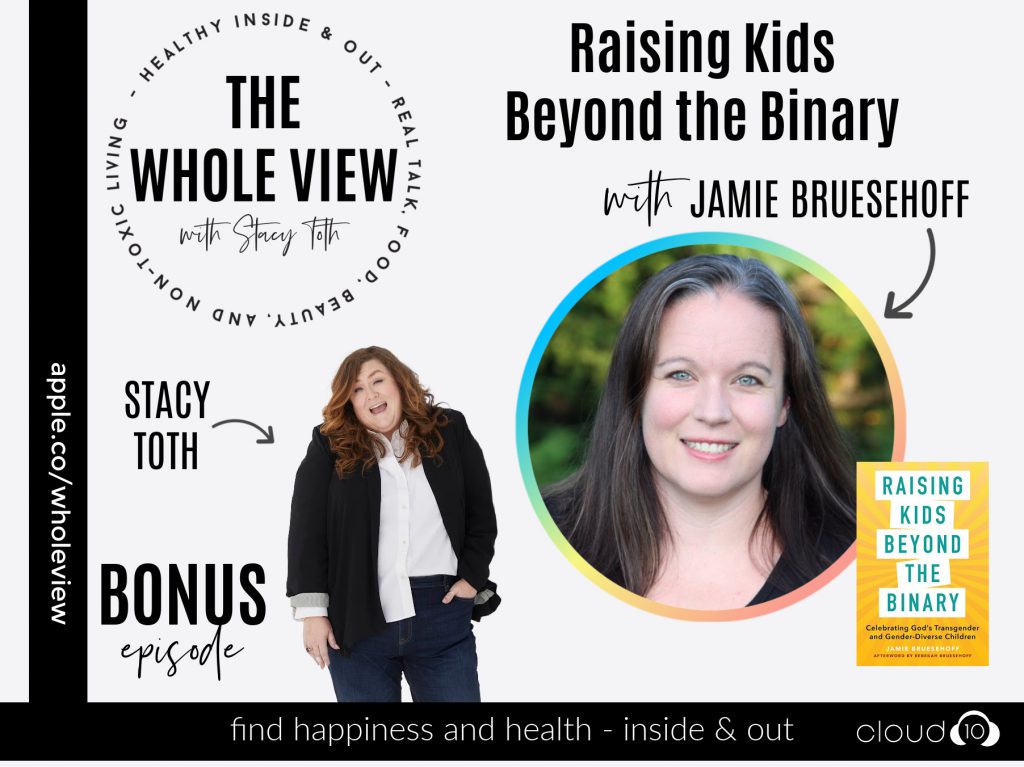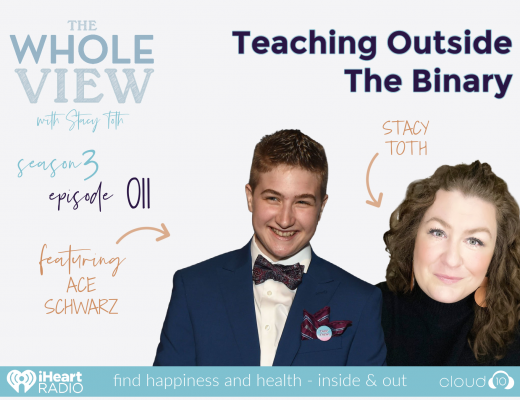In honor of LGBTQ+ Pride month, Stacy welcomes advocate and author of Raising Kids Beyond the Binary, Jamie Bruesehoff, for an emotional episode about raising transgender children. Their story is one of educating both themselves and others, navigating their family’s life in the public eye, the truth around gender-affirming care, and showing the world what transgender joy can look like. Jamie’s is a toolkit for families like theirs, helping parents navigate the emotional, spiritual, and logistical landscape of raising a gender-diverse child.
Trigger warning: This episode contains discussion of suicidality and self-harm. Please be mindful and take care of your needs accordingly. If you or someone you know is experiencing thoughts of suicide, you can call the Suicide and Crisis Lifeline by dialing 988 or connect to a crisis counselor 24/7 from anywhere in the US via text, chat or a call through the Trevor Project: thetrevorproject.org.

Find Jamie:
If you enjoy the show, please leave a review. Letting people know on iTunes or however you listen that it’s worth their time could change someone’s life!
Key Takeaways
Introductions
- Jamie Bruesehoff (she/they) is an award-winning advocate, speaker, and heartfelt writer. She is an openly queer woman married to a Lutheran pastor and mom to three spirited children, including a 17-year-old transgender daughter.
- She graduated Magna Cum Laude from Gettysburg College with a Bachelors of Arts in Religion then went on to receive her Masters of Arts in Religion with a concentration in Theology for Outdoor Ministry from the Lutheran Theological Seminary at Gettysburg.
- Jamie is passionate about sharing her family’s story, because she believes our stories are bridges to understanding, compassion, and celebration. Her first book, Raising Kids Beyond the Binary: Celebrating God’s Transgender and Gender Diverse Children is available for wherever books are sold
Raising Kids Beyond the Binary
I want every child to have the opportunity to walk with support, love, and affirmation…loving your kid shouldn’t be extraordinary. – Jamie Bruesehoff
- Jamie’s family and her transgender daughter Rebekah found themselves in the public eye when their daughter went viral. When she was 10, she was at an event with a sign that said “I’m the scary transgender person the media warned you about”. It was the first time Rebekah saw other transgender youth did NOT have the support she did. And their family’s public advocacy started. The impact of Rebekah publically being herself has given others hope.
- So Jamie and their family had to do a lot of educating for themselves, their extended family, their church, their school, etc. Jamie and her husband both have advanced degrees in theology, but wanted to write a more personal handbook for parents like them with some strings of faith throughout. It’s part memoir and part resource.
Did you know?
- The American Academy of Pediatrics says “conversion” or “reparative” treatment models are used to prevent children and adolescents from identifying as transgender or to dissuade them from exhibiting gender-diverse expressions. The Substance Abuse and Mental Health Services Administration has concluded that any therapeutic intervention with the goal of changing a youth’s gender expression or identity is inappropriate. Reparative approaches have been proven to be not only unsuccessful but also deleterious and are considered outside the mainstream of traditional medical practice. So the AAP described reparative approaches as “unfair and deceptive.”
- LGBTQ+ young people are more than four times as likely to attempt suicide than their peers (Johns et al., 2019; Johns et al., 2020).
- The Trevor Project’s 2023 U.S. National Survey on the Mental Health of LGBTQ Young People found that 41% of LGBTQ+ young people seriously considered attempting suicide in the past year, including roughly half of transgender and nonbinary youth. Transgender and nonbinary young people experience higher risks of depression, thoughts of suicide, and suicide attempts compared to cisgender and straight individuals, including cisgender members of the LGBTQ+ community.
- Furthermore, a 2020 peer-reviewed study by The Trevor Project’s researchers, published in the Journal of Adolescent Health, found that transgender and nonbinary youth were 2 to 2.5 times as likely to experience depressive symptoms, seriously consider suicide, and attempt suicide compared to their cisgender LGBQ peers. [source]
- In 2012, the American Academy of Pediatrics made this statement: “Being transgender or gender variant implies no impairment in judgment, stability, reliability, or general social or vocational capabilities; however, these individuals often experience discrimination due to a lack of civil rights protections for their gender identity or expression.… [Such] discrimination and lack of equal civil rights is damaging to the mental health of transgender and gender variant individuals.” [source]
Gender Affirming Care Beyond the Binary
- Additionally, pediatric providers in a gender-affirmative care model (GACM) offer developmentally appropriate care that orients toward understanding and appreciating the youth’s gender experience. A strong, nonjudgmental partnership with youth and their families can facilitate exploration of complicated emotions and gender-diverse expressions while allowing questions and concerns to be raised in a supportive environment.5 In a GACM, the following messages are conveyed [source]:
- transgender identities and diverse gender expressions do not constitute a mental disorder;
- variations in gender identity and expression are normal aspects of human diversity, and binary definitions of gender do not always reflect emerging gender identities;
- gender identity evolves as an interplay of biology, development, socialization, and culture;
- and if a mental health issue exists, it most often stems from stigma and negative experiences rather than being intrinsic to the child.
- So it’s actually a lot easier on someone’s body to suppress puberty than to reverse through surgical interventions as an adult.
- The characteristic health care professionals seek when helping to understand if a child is transgender is “consistent, insistent, and persistent”.
- Jamie’s daughter Rebekah socially transitioned (i.e. this can involve using a different name and pronouns, and changing features like hair, etc) at the age of 8.
- The World Health Organization notes that [source]:
- Gender-affirmative health care can include any single or combination of a number of social, psychological, behavioural or medical (including hormonal treatment or surgery) interventions designed to support and affirm an individual’s gender identity.
- Furthermore, trans-related and gender diverse identities are not conditions of mental ill-health, and that classifying them as such can cause enormous stigma.
- Inclusion of gender incongruence in the ICD-11 should ensure transgender people’s access to gender-affirming health care, as well as adequate health insurance coverage for such services.
Studies, References, and Products
- Raising Kids beyond the Binary: Celebrating God’s Transgender and Gender-Diverse Children by Jamie Bruesehoff
- A Kids Book About Being Inclusive by Ashton Mota and Rebekah Bruesehoff
- Rebekah Bruesehoff
- The Trevor Project
- GLAAD
- World Health Organization (WHO): Gender incongruence and transgender health in the ICD
- The Trevor Project: Facts About Suicide Among LGBTQ+ Young People
- American Academy of Pediatrics: Ensuring Comprehensive Care and Support for Transgender and Gender-Diverse Children and Adolescents
- Suicidality Among Transgender Youth: Elucidating the Role of Interpersonal Risk Factors
- Suicide and Suicidal Behavior among Transgender Persons
Want more info on our Real Life? Healthy recipes, parenting tips, and general lifestyle stuff goes out in our Real Everything newsletter, join here.
So never want to miss a post, sale, or deal? Join my Healthy Inside & Out e-mail list for more info on non-toxic living and safer skincare!




